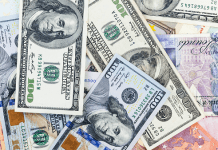- Japanese Yen (JPY) rises, adding to strong gains last week
- Japanese PPI rose to 3%
- US Dollar (USD) fall after cooling PPI inflation data
- US consumer inflation data is due tomorrow
The US Dollar Japanese Yen (USD/JPY) exchange rate fell on Tuesday after gains in the previous session. The pair rose 0.28% in the previous week, settling on Monday at 148.23. At 21:00 UTC, USD/JPY trades -0.11% at 146.86 and is in a range of 146.59 to 147.95
The Japanese Yen pushed higher again on Tuesday after modest losses in the previous session and after surging across the previous week.
The yen rose over 4% against the US dollar last week amid a combination of safe haven flows and the unwinding of the carry trade after the Bank of Japan hiked interest rates by 15 basis points and amid rising expectations that the Federal Reserve will cut rates.
Data overnight showed that Japanese wholesale inflation as measured by PPI rose to 3% year on year marking the sixth straight monthly gain and supported her more hawkish stance from the Bank of Japan.
Attention will now turn to Thursday’s Japanese GDP data for further clues about the resilience of the economy.
The US Dollar is falling across the board. The US Dollar Index, which measures the greenback versus a basket of major currencies, trades at 102.68 at the time of writing, down 0.5%, marking the second straight day of losses.
The US dollar fell on Tuesday, following weaker-than-expected US producer price inflation data (PPI).
The figures that measure inflation at the factory gate level eased to 2.2% year over year in July, down from 2.7%. This was below the expected 2.3%. Meanwhile, on a monthly basis, the PPI increased just 0.1%, showing that final demand in the US was weakening and supporting the view that the Fed could start to cut interest rates in September.
Attention is now turning to US CPI consumer price inflation data, which is expected to remain unchanged in July. Hotter-than-expected inflation data could fuel the market’s unwinding of the recent Fed rate hike. The market had increased expectations of a Fed rate count at the September meeting following weaker-than-expected U.S. jobs data at the start of August, which fuelled recession fears.
The market is currently fully pricing in a 25 basis point rate cut in September and sees a 50% probability of 50 points basis cut.





